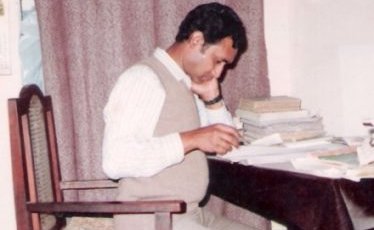WRITING A HOBBY TO KEEP REFRESHING AND IMPLEMENT CREATIVE THINKING

WRITING BOOK, WRITING ARTICLE(S), EDITING WORK HAVE BEEN FOUND TO BE A HOBBY INHERITED FROM MY FATHER WHO WAS SEEN ALWAYS BUSY WITH COMPOSING RELIGIOUS SONGS, WRITING BOOKS (BIOLOGY, ENGLISH, ECONOMICS) WRITING SCRIPT(S) FOR DRAMAS (RELIGIOUS OF HISTORICAL) ETC.
Besides teaching, writing articles has been found to be a creative moment for the benefit of the masses at large. Since teaching career started in a region dominated by Hindi medium schools, a habit was improvised to deal with the classroom subject using ‘Hindi’ and ‘English’ (terminology and language), both. This proved to be an additional advantage when taught for 10 years in Dehradun (Uttarakhand, India) where the classroom was usually dominated by students from elite class and English medium schools but Hindi medium school students (mostly thronging from hill districts of Uttarakhand or other nearby districts of Uttar Pradesh) were not uncommon.
Apart putting articles in English, a thirst of writing was quenched often by designing some articles in ‘Hindi’, on special occasions (like celebrated days), published in ‘VIGYAN PARICHARCHA’, a quarterly joint enterprise by UCOST (Uttarakhand Council of Science and Technology), ISWA (Indian Science Writers’ Association, Uttarakhand Chapter) and PAHAL( People’s Association of Hill-Area Launchers), a NGO working in Uttarakhand, India. The introductory issue of this Science Popularisation Magazine was released in July, 2010.
Articles have also been contributed to ‘VGYAN PRAGATI’, a Hindi monthly magazine by Council of Scientific and Industrial Research, Delhi (India).
To read more Click on the below mentioned Vigan Paricharcha articles
An Article from the pages of ‘Vigyan Paricharcha’ (विज्ञान परिचर्चा)
On the occasion of National Bird Day, 5th January
THE GUESTS WITHOUT PASSPORT: MIGRATORY BIRDS
बिना पास पोर्ट के मेहमान
An Article from the pages of ‘Vigyan Paricharcha’ (विज्ञान परिचर्चा)
Entitled: ‘Apna Vigyan Gyan Badhaeeye’
‘Enhance your knowledge about Science’
viuk foKku Kku c<+kbZ;s
v
Animal poison, Poisonous Animals
tUrq fo”k] fo”kSys tUrq
THE ESSENCE OF THE ARTICLEThis article is devoted to all those animals which are often said to be TOXIC / POISONOUS / VENOMOUS. Curiously enough, they include a vast array of animals from very simple unicellular microscopic PROTOZOANS to more complex MAMMALS. The words TOXIC / POISONOUS / VENOMOUS appear synonymous but are differently defined, biologically. To be poisonous is a defensive mechanism adopted by these animals.
· TOXINS [ toxic + in = organic poison, especially produced by bacteria in an animal’s body; toxic from Latin toxicus = poisoned or toxicum = poison; Greek toxikon = poison for use on arrows or toxikos = pertaining to arrows or archery]:
Basically, Toxins are Proteins, secreted by Bacteria, Protozoa, marine animals, freshwater blue-green algae or fungi. They are actually produced as byproducts of biological reactions. The toxins of proteinous nature are mainly ‘cytotoxins’[affecting the cells] or ‘neurotoxins’ [affecting nervous system]. The cytotoxins are responsible for the diseases like Anthrax, Diphtheria, Dysentery or Plague. The neurotoxic proteins include Botulinum, Tetanus, Scorpion venom, Snake venom etc.
· VENOMS and POISONS:
These two words are often used interchangeably. In Hindi, both are meant for ‘poisonous’ but in English both are indicated differently e.g., a poisonous insect or a venomous insect. The difference between a venom and poisons is the delivery mechanism involved.
· Venom [Anglo-French venin, venym = poison secreted by some animals and transferred by biting; Old French venim or venin = poison, malice; Latin venenum = poison] is a secretion containing a toxin or a complex mixture of toxins, produced by a great variety of invertebrates and vertebrates, both predators and prey (= venomous animals). It is produced by a special organ (gland) and delivered/injected into the body of another animal through a bite, sting and other device e.g., through special teeth (fangs) in snakes or through a sting in honey bees.
Many ants, vasps, spiders, centipedes, scorpions, butterflies, fish etc. are among other animals, infamous as to be venomous.
The venomous animals kill thousands of human beings per annum through at least 4 major classes of ‘toxins’ present therein viz.,
Necrotoxins and cytotoxins – killing cells.
Neurotoxins – affecting nervous system via blocking the ion channel and thus the conductance of nerve impulse; and
Myotoxins – damaging the muscles.
· Poison [Old French poison or puison = a drink, especially a medical drink or a magic potion or a drink that contains medicine, poison having magical powers; Latin potioneum or potio = a drinking or poisonous drink]. Literally, poison means ‘a deadly potion or substance’. Biologically, poisons are death causing substances, injuring the organs by hampering chemical reactions at molecular level; when absorbed in sufficient quantities. The ‘poisonous animals’, thus, prove to be poisonous/deadly when they either come in contact with other animal’s body or are devoured / ingested as a whole. Right goes the saying, “If you bite and you die, it is poison. If it bites you and you die, it is venom”. If some ailment develops after consuming contaminated food, it is ‘food-poisoning’ [not ‘food-venoming’]. In reality, the poisonous substance (toxin) is present in the entire body or in a specific part of the body of the ‘poisonous animal’.
· TOXICOLOGY[Greek toxicon = arrow poison + logos or logy = discourse of study]:
The study of toxins/poisons or the study of how chemicals interfere with the normal functioning of a biological system is called as TOXICOLOGY.
· FATHER OF TOXICOLOGY:
Swiss Physician, Theophrastus Phillipus Auroleus Bombastsus von Hohenheim (1493 – 1541), also known as Paracelsus, is aptly considered as the ‘father of Toxicology’. He is credited with the classic toxicology maxim, “All things are poisonous and nothing is without poison; only the dose makes a thing poisonous” [=“the dose makes the poison” = “Sola dosis facit venenum”, in Latin].





